Translate this page into:
A review on key aspects of wet granulation process for continuous pharmaceutical manufacturing of solid dosage oral formulations
⁎Corresponding authors. colourfulseason9@163.com (Ping Chen), lotfor@ums.edu.my (Md Lutfor Rahman) colourfulseason9@163.com (Md Lutfor Rahman)
-
Received: ,
Accepted: ,
This article was originally published by Elsevier and was migrated to Scientific Scholar after the change of Publisher.
Peer review under responsibility of King Saud University.
Abstract
Wet granulation process is a major unit operation in production of pharmaceuticals as solid dosage oral formulation. Indeed, granulation is used to improve the formulation properties such as flowability, compressibility, and so on for pharmaceutical manufacturing. Different types of granulations can be used in pharmaceutical manufacturing in which the selection of proper process depends on the operational conditions as well as formulation properties. In current decades, twin-screw wet granulation has been of paramount interest owing to its superior properties. Pharmaceutical manufacturing industry are trying to move towards continuous mode by which the efficiency can be improved compared to the batch mode. Therefore, development of continuous granulation process is of great importance. In this review article, various processing units applicable for wet granulation of pharmaceutical formulations for solid dosage forms are reviewed and discussed. The advantages and disadvantages of the processes are discussed and listed along with modeling approaches for simulation of process. The governing models and numerical schemes applicable for design of wet granulation are also critically discussed. The main focus is on wet granulation as this method has attracted much attention in pharmaceutical processing.
Keywords
Granulation process
Modelling
Pharmaceutical processing
Particle technology
1 Introduction
Preparation and manufacturing of solid dosage oral formulations constitutes main portion of pharmaceutical manufacturing due to the main application of solid dosage drugs which can be orally administered for different remediation and treatments (Raissy et al., 2022; Davoodnia, 2011; Halim, Mohamad, Pm, Zakaria, and Muhammad, 2019; Suliman et al., 2015; Fattepur et al., 2018). Manufacturing lines include various processing steps so that each unit plays its role in preparation of drug products. Compared to preparation of biopharmaceuticals, small molecules pharmaceutical production can be run in continuous mode. In the manufacturing line, granulation plays crucial role which deals with particle flow and solid-state processing (Ang et al., 2018; Itodo et al., 2020; Bibi et al., 2021; Emrani et al., 2011). Granulation is identified as the enlargement process of small particles into granules. This process is extensively applied in disparate industrial-based applications like pharmaceutics, food and chemical (Portier et al., 2020; Ghafarifarsani et al., 2021/12/01/ 2021.; Ghafarifarsani et al., 2022/02/15/ 2022.; Deng et al., 2021/02/01/ 2021.; Guo et al., 2020). Engineering control of granulation is of critical importance for manufacturing drugs with enhanced efficacy (Zulhabri, 2019; Abdul et al., 2021; Khan et al., 2020). Granulation is usually done to enhance the powders flowability and avoid the co-mixing of substances (Ennis, 2016). Important granule characteristics including granule size distribution (GSD) and porosity can be driven using the rate of disparate macroscopic mechanisms such as nucleation, aggregation and consolidation (Dhenge et al., 2012; Kumar et al., 2013; Emrani et al., 2011). Despite the emergence of different challenges, continuous processing has been recently of great interest for all important industries owing to its great potential of application with various advantages for the process. Table 1 aims to present the advantages and challenges towards the use of continuous processing for different types of industries.
Advantages
Challenges
Improved level of throughput
Modulating flow and level control
Reduction of inventory and related storage
Real-time in-process quality
Enhanced process safety
Real-time quality control
Reduced amount of air, water and power application
The need for personnel training
Decrease in the clean-up time
Superfluous controls and instrumentation
Reduced operator involvement
Fast corrections in various operating conditions
Reduced process footprint
Advanced process control
One of the prominent positive points of continuous processes is the non-existence of scale-up between clinical production and commercial manufacturing. Hence, continuous processes may prevent time wasting and expensive bio-equivalence investigations (Teżyk et al., 2016; Vercruysse et al., 2015; Bibi et al., 2021; Babanezhad et al., 2020). Additionally, continuous manufacturing processes are appropriate for the implementation of process analytical technology (PAT) tools, which guarantee permanent product quality and therefore, permitting a real time release strategy (Portier et al., 2020; Byrn et al., 2015; Qahir et al., 2021; Pishnamazi et al., 2020). PAT is an important tool in development of continuous manufacturing and plays crucial role in the regard for pharmaceutical manufacturing.
Various granulation processes have been developed and employed for solid particles such as high shear granulation, roller compaction, fluidized bed, twin-screw granulator, etc. Application of granulation process depends on the formulation and material properties. Twin-screw granulation (TSG) is an outstanding continuous process, which possesses great potential of application and excellent efficacy in granulating powders. This technique has brilliant advantages such as negligible residence time, superior management of granule properties, and great combination of active pharmaceutical ingredients (APIs) (Seem et al., 2015.; Dhenge et al., 2010; Ismail et al., 2020; Cao et al., 2021; Shirazian et al., 2018). Due to the abovementioned characteristics, twin-screw granulation has been recently of paramount attention in continuous granulation of pharmaceutical powders for oral dosage formulations. With the aim of effective implementation of the twin-screw granulator, promising mechanistic modeling can be developed for the continuous granulation in twin-screw granulation process. Development of promising models are important to facilitate the continuous granulation of APIs and implementing the Quality-by-Design (QbD) paradigm. Figs. 1 and 2 illustrate the developed experimental setup and screw configuration applied for twin-screw wet granulation for pharmaceutical formulations. As seen the twin-screw granulator consists of different elements such as extruder, screws, liquid injection pump, and feeder.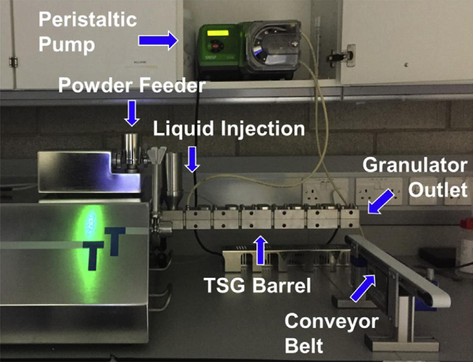
Experimental set up for twin-screw wet granulation. Reprinted from (Shirazian et al., 2018) with permission from Elsevier.

Screw configuration applied for twin-screw wet granulation. Reprinted from (Ismail et al., 2020) with permission from Elsevier.
The prominent aim of this manuscript is to provide a comprehensive overview on the state-of-the-art of modeling approaches such as PBM, DEM and ANN towards granulation process. As the future outlook, a number of questions have been recognized and responded to fill the existed knowledge gap towards the development of the granulation process in pharmaceutical applications.
2 Current modeling approaches for different granulation techniques
It has been recently identified that the existence of promising mathematical models may considerably eventuate in the creation of functional knowledge-based control of process (Ismail et al., 2020; Cao et al., 2021; Pishnamazi et al., 2020; Ghafarifarsani et al., 2021). Unfortunately, the majority of applied parameters in high shear wet granulation models are hard to measure. The majority of analyses on the basis of disparate types of granulation models are usually perceived to be implemented under default parameter values. This is prominently because of significant difficulties in the achievement of experimental data or paucity of appropriate measurement equipment to validate the developed model. Hence, it would be of great importance to describe appropriate mathematical models for granulation process. This section aims to review the state-of-the-art advancements in modeling approaches for different granulation techniques, which results in the perception of functional/operational gaps and thus, finding possible ways to face with the challenges. It has been reported that there are three main methods for modeling granulation: 1) population balance model (PBM), 2) Discrete Element Method (DEM), and 3) Machine Learning (ML) methods (Kumar et al., 2013; Elveny et al., 2021; Barrera Jiménez et al., 2021).
2.1 Population balance modeling
The population balance modeling (PBM) is identified as an efficient model to statistically interpret a system of particles that undergoes size increment and/or reduction. Indeed, PBM delas with particulate processes to track the evolution of particles properties. Apart from granulation, PBM technique possess great potential of use in disparate engineering sciences such as crystallization, aerosols coagulation and polymerization (Ramkrishna, 2000). In the high-shear wet granulation process, the population balance equation for a well-mixed system can be derived as follows (Pinto et al., 2007):
In this equation,
,
and
are described as the continuous growth along the internal direction of the particle diameter, the net formation and depletion rates of particles, respectively. Contribution of the aggregation impacts and breakage eventuates in modifying the Eq.1 to the following equation (Cameron et al., 2005):
In the pharmaceutical industry, granulation is often implemented as batch processes and thus, the majority of modeling investigations regarding to pharmaceutical granulation have concentrated on batch processes. In batch process, there is no spatial coordinate involved in the model owing to the assumption of a well-mixed system, but the model of a continuous system consists of both internal and external coordinates, which is presented by the following equation (Drumm et al., 2009):
In the abovementioned equation,
is explained as the spatial velocity in the external coordinate. Simultaneous application of computational fluid dynamics (CFD) and discrete element method (DEM) has shown brilliant potential for numerical definition of particle flow regime and their visit frequency through a special granulator zone (Garth et al., 2011; Babanezhad et al., 2020; Raissy et al., 2022). Moreover, the DEM may be combined with the PBM by considering a dense flow of particles (Freireich et al., 2011; Li et al., 2012; Gantt et al., 2006). For high-shear wet granulation, the combination of PBM and DEM approaches has shown appropriate performance. Fig. 3 represents the knowledge development framework (KDF) applying modeling and measurement equipment.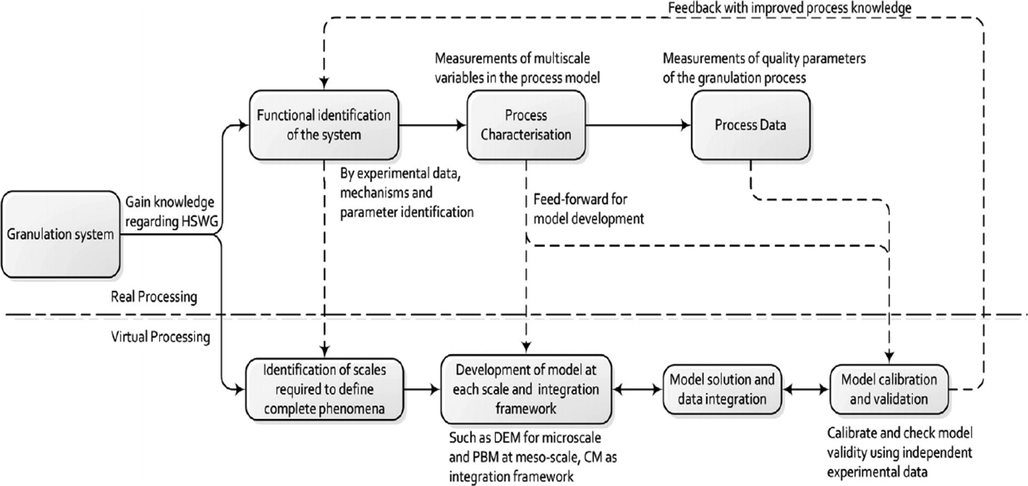
Schematic demonstration of the KDF applying modeling and measurement equipment. Reprinted from (Kumar et al., 2013) with permission from Elsevier.
2.2 Discrete element method
In recent years, discrete element method (DEM) is identified as a bridge to overcome the disadvantages of the PBM approach in micro- and meso-scales (Deng et al., 2021.; Nakamura et al., 2013; Ketterhagen and Ende, and Hancock, 2009; Marjani et al., 2021; Ghafarifarsani et al., 2021; Gantt and Gatzke, 2005). Two prominent classifications of DEM include hard-sphere (HS) and soft-sphere (SS) methods, which are of great application in granulation modeling. Table 2 aims to present comprehensive information about the advantages and disadvantages of different DEM methods. These approaches have been investigated by various researchers (Ang et al., 2018; Liu et al., 2013; Herrmann and Luding, 1998; Nakhjiri and Roudsari, 2016; Babanezhad et al., 2020; Kumar et al., 2021). The HS approach assumes the rigidity of particles. Therefore, the collision of particles is rapid and binary, which is not valid for extremely dense high-shear wet granulation system. In the SS approach, the instantaneity of contacts cannot be assumed and the simultaneous presence of more than one contact is possible. Fig. 4 schematically illustrates the normal and tangential contact forces applying a spring, dashpot and slider approach.
Model
Advantages
Challenges
Ref.
PBM
Simulation of a great number of particles
Semi-mechanistic approach because of the paucity of process knowledge
(Ramachandran et al., 2009; Gantt and Gatzke, 2006)
DEM
Mechanistic attitude
Computational restrictions
(Ketterhagen and M. T. am Ende, and B. C. Hancock, , 2009)
Hybrid PBM-DEM
Ability of modeling complicated dynamic mechanisms by interconnection of micro-scale to meso-scale
Difficulty of implementation
Owing to challenges like wet granule yield strength, asperity height and so on.(Sen et al., 2012; Štěpánek et al., 2009)
PBM with volume of fluid VoF procedures
Mechanistic attitude
spatial distribution of binder in wet granuleDifficulty of implementation
Requirement of considerable simplification(Rajniak et al., 2009)
Hybrid PBM-CFD
Mechanistic approach
Ability of application for developing simplified modelLack of suitability for dense particle system
Neglection of particle–particle interaction(Shirazian et al., 2017; Bouffard et al., 2012)
Hybrid PBM-CM-DEM
Enhanced precision of the PBM
Low number of particles
(Bouffard et al., 2012; Babanezhad et al., 2021)
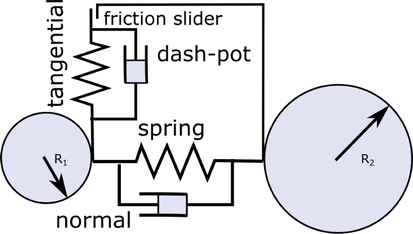
Schematic demonstration of the normal / tangential contact forces applying a spring, dashpot and slider approach. Reprinted from (Kumar et al., 2021).
The following equations are derived to express linear / angular momentum equations for each granule in the granulator as follows (Kumar et al., 2013):
DEM possesses some privileges in comparison with PBM in cases of good capability to express complicated particle–particle interaction laws and to permit distribution of properties. Unlike DEM, PBM doesn’t have the potential of application for theoretical-based process design owing to powder specifications and important hydrodynamic parameters regarding liquid–solid interaction. Additionally, DEM can be well applied to compute numerous particle-scale quantities of interest like local concentrations and particle phase stresses throughout the implementation of simulation (Ang et al., 2018; Ketterhagen and M. T. am Ende, and B. C. Hancock, 2009; Liu et al., 2013; Kazemi et al., 2016). Despite the abovementioned advantages, significant computational cost is the main drawback of DEM, which can be taken place owing to the small integration time-step applied in this technique.
2.3 Artificial neural network model
The artificial neural network (ANN) model is a novel and promising model approach which can be used for simulation of wet and dry granulation processes. This technique is classified as Machine Learning (ML) method in simulation of processes which needs measured data for model’s calibration. The technique has been successfully used for simulation of twin-screw granulation which include three input operational parameters such as liquid to solid ratio, screw speed and powder flow rate. In different circumstances, d-values of particle size distribution can be regarded as response parameters for the ML model. Fundamentally, the ANN model contains three layers including input, hidden and output layers (Yu et al., 2015; Khan et al., 2020; Babanezhad et al., 2020; Babanezhad et al., 2021; Gong et al., 2018). The hidden layers contain various nodes for prediction of the output. Validation procedure, activation function, hidden layers and nodes number in each layer of network are identified as the principal parameters in the advancement of ANN model for prediction of granulation process. The abovementioned parameters are of great importance to perceive the optimized ANN topology for estimating the process. Discovery of the optimum ANN topology is an important challenge towards the development of ANN model due to the non-existence of straightforward method for this. Fig. 5 illustrates the topology of the boosted ANN employed for a TSG process (Yu et al., 2015; Othman et al., 2019; Babanezhad et al., 2020; Shirazian et al., 2017).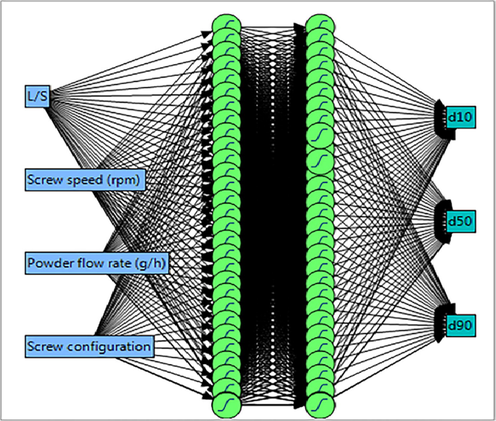
Schematic demonstration of the boosted ANN topology for estimation of granules d-values. Reprinted from (Shirazian et al., 2017) with permission from Elsevier.
To solve the PBM, solution time is of great need to achieve great results in terms of stability and accuracy as well. In recent years, ANN has been developed to prognosticate the particles mean residence time (MRT), needed for the simulation of particle size distribution in a twin-screw wet granulation. Hence, the hybrid ANN-PBM model is of great interest to consider process parameters and materials properties as inputs (Ismail et al., 2020). Fig. 6 schematically demonstrates the optimized ANN topology achieved by trial and error for prediction of MRT.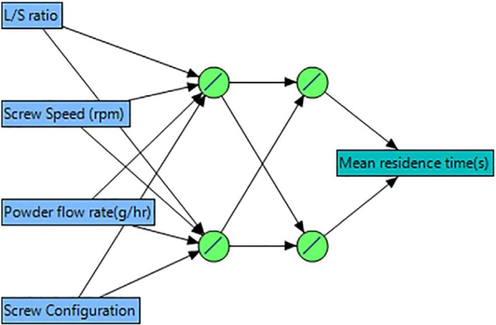
Schematic demonstration of the boosted ANN topology for prediction of MRT. Reprinted from (Ismail et al., 2019) with permission from Elsevier.
2.4 Mass conserving finite volume scheme (FVS)
Apart from the modeling approaches applicable for granulation process, the numerical schemes also play crucial role, particularly for the solution of PBM. The numerical schemes have been currently of paramount interest to discretize the PBM such as finite volume scheme (FVS). This procedure is on the basis of total mass conservation in the system via the addition of two simple weights to the discrete formulation. In order to obtain the mathematical formulation of the FVS, the assumption of particle properties concentration on the mean of the cells must be taken into account. With the aim of developing the formulation of the FVS, the discrete computational domain is built from a continuous domain with upper limit. The mean of each cell of the domain can be derived as follows (Singh et al., 2015; Barrasso and Ramachandran, 2012):
is known as the step size of the ith cell. Ni is defined as the number of particles in ith cell and can be predicted using the following equation (Singh et al., 2015; Barrasso and Ramachandran, 2012):
The FVS is on the basis of modifying the PBM equation into a series of ordinary differential equations via integrating the boundaries of the ith cell as follows (Singh et al., 2015; Barrasso and Ramachandran, 2012):
Owing to the assumption of concentrated particle properties on the cells, the number density function may be rendered by a set of delta functions as follows (Singh et al., 2015; Barrasso and Ramachandran, 2012):
Combination of two abovementioned equations results in achieving the following equation (Singh et al., 2015; Barrasso and Ramachandran, 2012):
In this equation, Bi and Di relate to simultaneous aggregation-breakage mechanisms in the ith cell. Table 2 aims to comprehensively review disparate physical modeling approaches in granulation investigations.
3 Conclusion and future perspectives
Granulation has been recently perceived as an indisputably important processes in the pharmaceutical industry for the efficient manufacturing of various types of drugs in commercial scale. The prominent purpose of this technique is to fabricate granules applied directly as drugs or perform as an intermediate product in tablets / capsules. This paper aims to provide a short overview on the state-of-the-art of modeling approaches such as PBM, DEM and ANN towards granulation process. Paradigm alteration from batch to continuous granulation process has been an important turning point for the pharmaceutical industry and manufacturing of solid dosage forms. First-principles modeling approaches have recently attracted paramount attentions due to playing an indisputable role in optimization and control of important quality parameters in pharmaceutical granulation. Despite their importance, they must possess an acceptable level of reliability to obtain the purpose of simulation for granulation. By increasing the model dimensions, the existed modeling approaches have demonstrated performance constraints. Therefore, this important limitation has encouraged the investigators to develop more computationally-efficient mathematical procedures to facilitate the numerical modeling of pharmaceutical processes such as granulation.
References
- Q. Abdul, K. Attiq-Ur-Rehman, K. Naqeebullah, Samiullah, H. Abdul, K. Rehana, et al., “The antioxidant, antimicrobial, and clinical effects with elemental contents of pomegranate (Punica granatum) peel extracts: A review,” Baghdad J. Biochemistry Appl. Biological Sci., vol. 2, pp. 21-28, 03/08 2021.
- Biochemical Characterization of the Cytochrome P450 CYP107CB2 from Bacillus lehensis G1. Protein. J.. 2018;37:180-193.
- [Google Scholar]
- Prediction of turbulence eddy dissipation of water flow in a heated metal foam tube. Sci. Rep.. 2020;10:1-12.
- [Google Scholar]
- Functional input and membership characteristics in the accuracy of machine learning approach for estimation of multiphase flow. Sci. Rep.. 2020;10:1-15.
- [Google Scholar]
- Computational modeling of transport in porous media using an adaptive network-based fuzzy inference system. ACS Omega. 2020;5:30826-30835.
- [Google Scholar]
- Pattern recognition of the fluid flow in a 3D domain by combination of Lattice Boltzmann and ANFIS methods. Sci. Rep.. 2020;10:1-13.
- [Google Scholar]
- High-performance hybrid modeling chemical reactors using differential evolution based fuzzy inference system. Sci. Rep.. 2020;10:1-11.
- [Google Scholar]
- Performance and application analysis of ANFIS artificial intelligence for pressure prediction of nanofluid convective flow in a heated pipe. Sci. Rep.. 2021;11:1-18.
- [Google Scholar]
- Thermal prediction of turbulent forced convection of nanofluid using computational fluid dynamics coupled genetic algorithm with fuzzy interface system. Sci. Rep.. 2021;11:1-12.
- [Google Scholar]
- A comparison of model order reduction techniques for a four-dimensional population balance model describing multi-component wet granulation processes. Chem. Eng. Sci.. 2012;80:380-392.
- [Google Scholar]
- Improvement of a 1D Population Balance Model for Twin-Screw Wet Granulation by Using Identifiability Analysis. Pharmaceutics. 2021;13:692.
- [Google Scholar]
- M. Bibi, S. Khan, A.-U.-R. Kakar, N. Khan, A. H. Tareen, S. Bibi, et al., “Determination of essential and non-essential elements in Xylanthemum macropodum of Balochistan, Pakistan,” Baghdad J. Biochem. Appl. Biol. Sci., vol. 2, pp. 95-105, 06/30 2021.
- Determination of essential and non-essential elements in Xylanthemum macropodum of Balochistan, Pakistan. Baghdad J. Biochemistry Appl. Biological Sciences. 2021;2:94-103.
- [Google Scholar]
- A multiscale model for the simulation of granulation in rotor-based equipment. Chem. Eng. Sci.. 2012;81:106-117.
- [Google Scholar]
- Achieving continuous manufacturing for final dosage formation: challenges and how to meet them. May 20–21, 2014 continuous manufacturing symposium. J. Pharm. Sci.. 2015;104:792-802.
- [Google Scholar]
- Process systems modelling and applications in granulation: A review. Chem. Eng. Sci.. 2005;60:3723-3750.
- [Google Scholar]
- Intensification of CO 2 absorption using MDEA-based nanofluid in a hollow fibre membrane contactor. Sci. Rep.. 2021;11:1-12.
- [Google Scholar]
- Recent advancements in molecular separation of gases using microporous membrane systems: A comprehensive review on the applied liquid absorbents. J. Mol. Liq. 2021116439
- [Google Scholar]
- A highly efficient and fast method for the synthesis of biscoumarins using tetrabutylammonium hexatungstate [TBA] 2 [W 6 O 19] as green and reusable heterogeneous catalyst. Bull. Korean Chem. Soc.. 2011;32:4286-4290.
- [Google Scholar]
- A. Davoodnia, “ A Highly Efficient and Fast Method for the Synthesis of Biscoumarins Using Tetrabutylammonium Hexatungstate [TBA]2[W6O19] as Green and Reusable Heterogeneous Catalyst,” Bulletin of the Korean Chemical Society, vol. 32, pp. 4286-4290, 12/20 2011.
- Inter-hours rolling scheduling of behind-the-meter storage operating systems using electricity price forecasting based on deep convolutional neural network. Int. J. Electr. Power Energy Syst.. 2021;125:106499
- [Google Scholar]
- M. Elveny, A. Khan, A. T. Nakhjiri, and A. B. Albadarin, “A state-of-the-art review on the application of various pharmaceutical nanoparticles as a promising technology in cancer treatment,” 2021.
- Alumina supported ammonium dihydrogenphosphate (NH 4 H 2 PO 4/Al 2 O 3): Preparation, characterization and its application as catalyst in the synthesis of 1, 2, 4, 5-tetrasubstituted imidazoles. Bull. Korean Chem. Soc.. 2011;32:2385-2390.
- [Google Scholar]
- A. Emrani, A. Davoodnia, and N. Tavakoli-Hoseini, “ Alumina supported ammonium dihydrogenphosphate (NH4 H2PO4/Al2O3): Preparation, characterization and its application as catalyst in the synthesis of 1, 2, 4, 5-tetrasubstituted imidazoles,” Bulletin of the Korean Chemical Society, vol. 32, pp. 2385-2390, 07/20 2011.
- B. J. Ennis, “Theory of granulation: An engineering perspective,” in Handbook of Pharmaceutical Granulation Technology, ed: CRC Press, 2016, pp. 22-74.
- S. Fattepur, K. Nilugal, T. Darshan, M. F. Bacayo, F. Asmani, I. Abdullah, et al., “Toxicological and pharmacological activity of ethanolic extracts of Catharanthus roseus in expermental animals,” International Journal of Medical Toxicology & Legal Medicine, vol. 21, p. 141, 01/01 2018.
- Incorporating particle flow information from discrete element simulations in population balance models of mixer-coaters. Chem. Eng. Sci.. 2011;66:3592-3604.
- [Google Scholar]
- Determination of coalescence kernels for high-shear granulation using DEM simulations. Powder Technol.. 2006;170:53-63.
- [Google Scholar]
- High-shear granulation modeling using a discrete element simulation approach. Powder Technol.. 2005;156:195-212.
- [Google Scholar]
- A stochastic technique for multidimensional granulation modeling. AIChE J.. 2006;52:3067-3077.
- [Google Scholar]
- CFD Simulation of Liquid-Liquid Extraction Columns and Visualization of Eulerian Datasets. Visualization of Large and Unstructured Data Sets: Applications in Geospatial Planning, Modeling and Engineering-Proceedings of IRTG. 2011;1131:59-70.
- [Google Scholar]
- H. Ghafarifarsani, S. H. Hoseinifar, M. Aftabgard, and H. Van Doan, “The improving role of savory (Satureja hortensis) essential oil for Caspian Roach (Rutilus caspicus) fry: Growth, haematological, immunological, and antioxidant parameters and resistance to salinity stress,” Aquaculture, p. 737653, 2021.
- The effects of combined inclusion of Malvae sylvestris, Origanum vulgare, and Allium hirtifolium boiss for common carp (Cyprinus carpio) diet: Growth performance, antioxidant defense, and immunological parameters. Fish Shellfish Immunol. 2021
- [Google Scholar]
- The effects of combined inclusion of Malvae sylvestris, Origanum vulgare, and Allium hirtifolium boiss for common carp (Cyprinus carpio) diet: Growth performance, antioxidant defense, and immunological parameters. Fish Shellfish Immunol.. 2021/12/01/ 2021.;119:670-677.
- [Google Scholar]
- The improving role of savory (Satureja hortensis) essential oil for Caspian roach (Rutilus caspicus) fry: Growth, haematological, immunological, and antioxidant parameters and resistance to salinity stress. Aquaculture. 2022;548:737653
- [Google Scholar]
- Artificial neural network modelling for organic and total nitrogen removal of aerobic granulation under steady-state condition. Environ. Technol. 2018
- [Google Scholar]
- J. Guo, C. Zhu, Y. Zhao, H. Wang, X. He, and D. Cai, LAMP: Label Augmented Multimodal Pretraining, 2020.
- S. Halim, N. Mohamad, R. Pm, N. H. Zakaria, and N. A. Muhammad, “In-vitro Study: Camp Overshoot Caused by Chronic Morphine Alleviated by the Synergistic Combination of Zamzam Water and Methadone in Human Primary Glioblastoma Cell Line (U-87 MG),” IIUM Medical Journal Malaysia, vol. 18, 2019.
- Modeling granular media on the computer. Continuum Mech. Thermodyn.. 1998;10:189-231.
- [Google Scholar]
- Compartmental approach for modelling twin-screw granulation using population balances. Int. J. Pharm.. 2020;576:118737
- [Google Scholar]
- Developing ANN-Kriging hybrid model based on process parameters for prediction of mean residence time distribution in twin-screw wet granulation. Powder Technol.. 2019;343:568-577.
- [Google Scholar]
- Detoxification of acetaminophen overdose using formulated carbo tablets. J. Medicinal Chemical Sciences. 2020;3:183-198.
- [Google Scholar]
- Computational intelligence modeling of granule size distribution for oscillating milling. Powder Technol.. 2016;301:1252-1258.
- [Google Scholar]
- W. R. Ketterhagen, M. T. am Ende, and B. C. Hancock, “Process modeling in the pharmaceutical industry using the discrete element method,” J. pharmaceutical sciences, vol. 98, pp. 442-470, 2009.
- J. Khan, S. Norfarhani, R. Sahu, S. Ruhi, M. Kaleemullah, S. Al-Dhalli, et al., “Development and evaluation of topical emulgel of aspirin using different polymeric bases,” RESEARCH JOURNAL OF PHARMACY AND TECHNOLOGY, vol. 13, pp. 6300-6304, 01/01 2020.
- Development and Evaluation of topical Emulgel of Aspirin using different Polymeric Bases. Research J. Pharmacy Technology. 2020;13:6300-6304.
- [Google Scholar]
- Model-based analysis of high shear wet granulation from batch to continuous processes in pharmaceutical production–a critical review. Eur. J. Pharm. Biopharm.. 2013;85:814-832.
- [Google Scholar]
- Particle-Scale Modeling to Understand Liquid Distribution in Twin-Screw Wet Granulation. Pharmaceutics. 2021;13:928.
- [Google Scholar]
- Particle-Scale Modeling to Understand Liquid Distribution in Twin-Screw Wet Granulation. Pharmaceutics. 2021;13:928.
- [Google Scholar]
- A general compartment-based population balance model for particle coating and layered granulation. AIChE J.. 2012;58:1397-1408.
- [Google Scholar]
- DEM study of the transverse mixing of wet particles in rotating drums. Chem. Eng. Sci.. 2013;86:99-107.
- [Google Scholar]
- Evaluation of potassium glycinate, potassium lysinate, potassium sarcosinate and potassium threonate solutions in CO2 capture using membranes. Arabian J. Chem.. 2021;14:102979
- [Google Scholar]
- Continuous processing in pharmaceutical manufacturing. Pharmaceutical Manufacturing Magazine 2004:1-9.
- [Google Scholar]
- Scale-up of high shear mixer-granulator based on discrete element analysis. Powder Technol.. 2013;236:149-156.
- [Google Scholar]
- Modeling and simulation of natural convection heat transfer process in porous and non-porous media. Appl. Res. J. 2016;2:199-204.
- [Google Scholar]
- Prediction of thermal distribution and fluid flow in the domain with multi-solid structures using Cubic-Interpolated Pseudo-Particle model. PLoS ONE. 2020;15:e0233850
- [Google Scholar]
- Z. Othman, H. R. H. Khalep, A. Z. Abidin, H. Hassan, and S. Fattepur, “The Anti-Angiogenic Properties of Morinda citrifolia. L (Mengkudu) Leaves Using Chicken Chorioallantoic Membrane (CAM) Assay,” Pharmacognosy Journal, vol. 11, 2019.
- A feasible solution technique for higher-dimensional population balance models. Comput. Chem. Eng.. 2007;31:1242-1256.
- [Google Scholar]
- Computational fluid dynamics simulation of NO2 molecular sequestration from a gaseous stream using NaOH liquid absorbent through porous membrane contactors. J. Mol. Liq.. 2020;313:113584
- [Google Scholar]
- Computational investigation on the effect of [Bmim][BF4] ionic liquid addition to MEA alkanolamine absorbent for enhancing CO2 mass transfer inside membranes. J. Mol. Liq.. 2020;314:113635
- [Google Scholar]
- Continuous twin screw granulation: Influence of process and formulation variables on granule quality attributes of model formulations. Int. J. Pharm.. 2020;576:118981
- [Google Scholar]
- The antioxidant, antimicrobial, and clinical effects with elemental contents of Pomegranate (Punica Granatum) Peel Extraction: A Review. Baghdad J. Biochemistry Applied Biological Sciences. 2021;2:21-28.
- [Google Scholar]
- The effect of dietary combined herbs extracts (oak acorn, coriander, and common mallow) on growth, digestive enzymes, antioxidant and immune response, and resistance against Aeromonas hydrophila infection in common carp. Cyprinus carpio Aquaculture. 2022;546:737287
- [Google Scholar]
- The effect of dietary combined herbs extracts (oak acorn, coriander, and common mallow) on growth, digestive enzymes, antioxidant and immune response, and resistance against Aeromonas hydrophila infection in common carp, Cyprinus carpio. Aquaculture. 2022;546:737287
- [Google Scholar]
- A combined experimental and computational study of wet granulation in a Wurster fluid bed granulator. Powder Technol.. 2009;189:190-201.
- [Google Scholar]
- A mechanistic model for breakage in population balances of granulation: Theoretical kernel development and experimental validation. Chem. Eng. Res. Des.. 2009;87:598-614.
- [Google Scholar]
- Population balances: Theory and applications to particulate systems in engineering. Elsevier; 2000.
- Challenges in process control for continuous processing for production of monoclonal antibody products. Curr. Opin. Chem. Eng.. 2021;31:100671
- [Google Scholar]
- Mathematical development and comparison of a hybrid PBM-DEM description of a continuous powder mixing process. J. Powder Technology. 2012;2013
- [Google Scholar]
- Artificial neural network modelling of continuous wet granulation using a twin-screw extruder. Int. J. Pharm.. 2017;521:102-109.
- [Google Scholar]
- Continuous twin screw wet granulation: The combined effect of process parameters on residence time, particle size, and granule morphology. J. Drug Delivery Sci. Technol.. 2018;48:319-327.
- [Google Scholar]
- Continuous twin screw wet granulation: The combined effect of process parameters on residence time, particle size, and granule morphology. J. Drug Delivery Sci. Technol.. 2018;48:319-327.
- [Google Scholar]
- A volume conserving discrete formulation of aggregation population balance equations on non-uniform meshes. IFAC-PapersOnLine. 2015;48:192-197.
- [Google Scholar]
- Distribution and accessibility of binder in wet granules. Powder Technol.. 2009;189:376-384.
- [Google Scholar]
- A New Approach for Predicting Antioxidant Property of Herbal Extracts. Int. J. Pharmacognosy Phytochemical Res.. 2015;7:166-174.
- [Google Scholar]
- Recent progress in continuous and semi-continuous processing of solid oral dosage forms: a review. Drug Dev. Ind. Pharm.. 2016;42:1195-1214.
- [Google Scholar]
- Use of a continuous twin screw granulation and drying system during formulation development and process optimization. Eur. J. Pharm. Biopharm.. 2015;89:239-247.
- [Google Scholar]
- Membrane distillation technology for molecular separation: a review on the fouling, wetting and transport phenomena. J. Mol. Liq. 2021118115
- [Google Scholar]
- Prediction of the particle size distribution parameters in a high shear granulation process using a key parameter definition combined artificial neural network model. Ind. Eng. Chem. Res.. 2015;54:10825-10834.
- [Google Scholar]
- O. Zulhabri, K. Hamimi Rasyiqah Hassan, A. Azrina Zainal, H. Halijah, and F. Santosh, “The Anti-Angiogenic Properties of Morinda citrifolia. L (Mengkudu) Leaves Using Chicken Chorioallantoic Membrane (CAM) Assay,” Pharmacognosy Journal, vol. 11, 2019.







